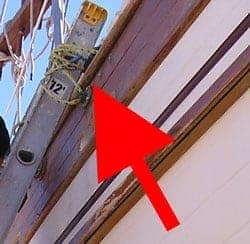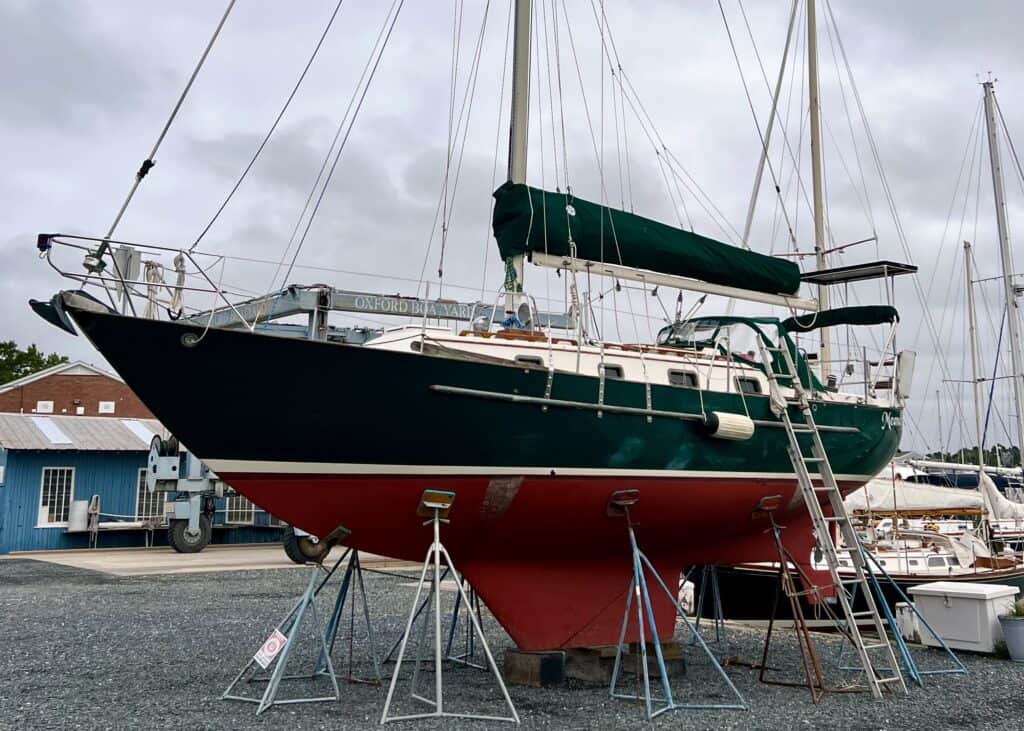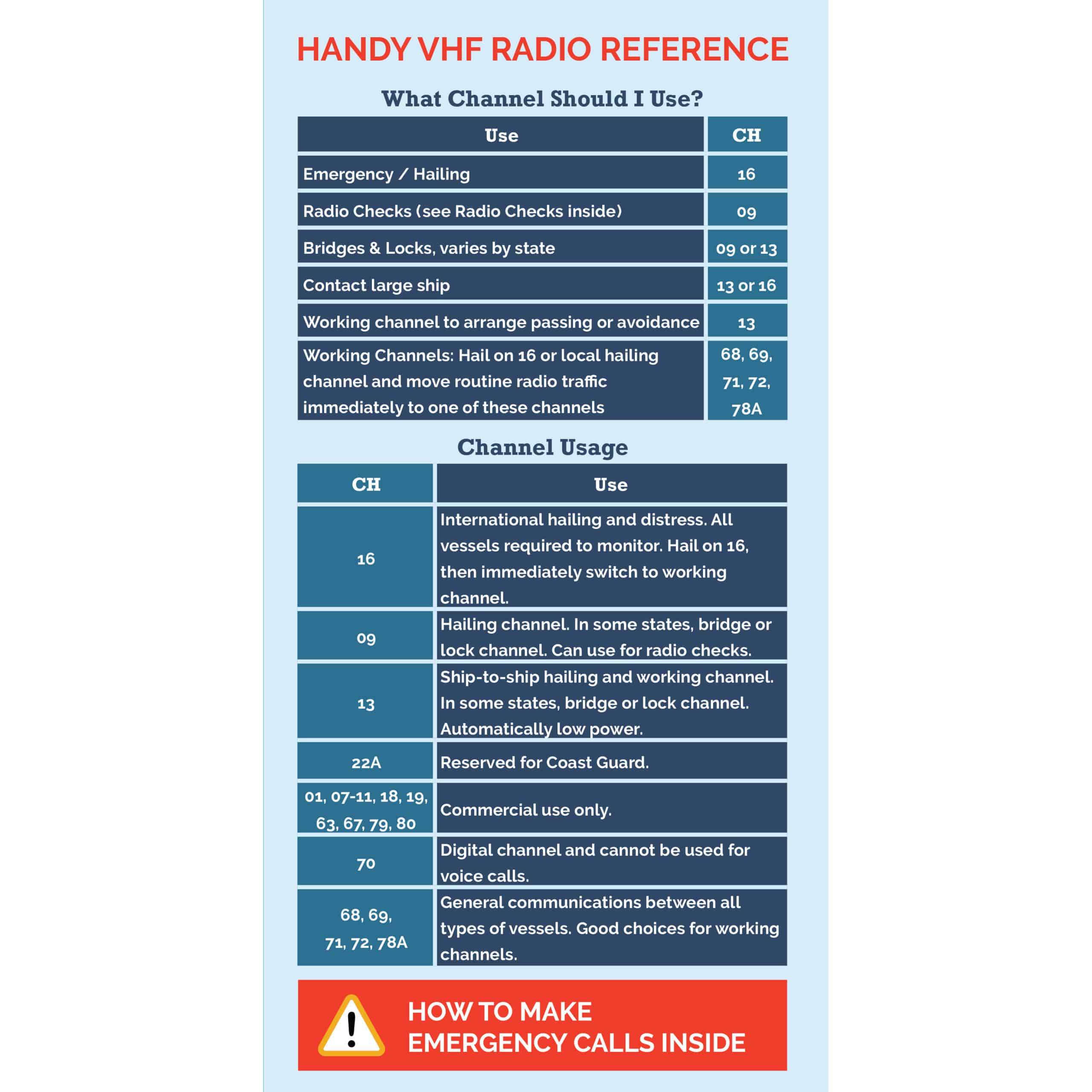Is it possible to be safe and comfortable when you’re living in a boatyard while your boat is hauled out? Sure. But it takes some thought.
Our First Haul Out
The first time we hauled — just for a few days to paint the bottom — my inclination was to say no, just because I was terrified of ladders. Heights didn’t bother me, ladders did.
However, once we started investigating motels within walking distance, I decided that I really didn’t want to spend $50 a night plus the expense of eating all our meals out. I’d deal with the ladder.
The yard we were in (Marina del Palmar — aka Abaroa’s — in La Paz, Mexico) had a nice bathroom with tons of hot water for the showers, and a wonderful outdoor sink for dishes. The only bad thing was having to go down the ladder every time we needed the bathroom — even in the middle of the night!
I figured out a bunch of things in those few days. Six months later we hauled for a total of four months on the hard as we did major work on the boat — replacing the teak decks with fiberglass, painting the boat, rigging upgrades and more — and we stayed aboard all but a few days when the boat was being painted. That totally got me over my fear of ladders!
Issues While Living in the Boatyard

Four months of living on the hard taught me a lot about the “galley issues” that arise when living on a boat up in the air. Here are a few tips (and please add any of your own in the comments below):
Ladders
- It’s not really a galley issue, but it’s much easier to go up and down the ladder multiple times a day if the ladder is the proper length. Place it so the top rung is right at the gunwale (because I took the photo from the ground, the photo doesn’t look like the ladder rung is at the same level as the top of the gunwale, but it is). Not having to step up and over and not having the top step a few inches below the gunwale makes it a lot safer. Of course, make sure that the ladder is securely tied to the boat at the top. And it’s best to tie both sides of the ladder so that it can’t twist or flip over if you lose your balance a tiny bit and put all your weight on one side.
- Again, not really a “galley issue” except as you may be coming up the ladder with a load of provisions — as you step aboard from the ladder, don’t use the lifeline stanchions as grab bars (same as getting aboard from the dock or dinghy). Constantly pulling on them can cause leaks.
Bringing Things Aboard
Whether provisioning or doing work, you’ll need to bring stuff onboard via ladder. Here’s how we managed:
- We discovered several ways of getting provisions aboard, depending on what it was. The easiest is to put things in a day pack and carry it up on your back That leaves both hands free. Don’t just sling the daypack over one shoulder, as it will swing as you go up the ladder and possibly throw you off balance.
- With two of us, one would often go part way up and the one on the ground could hand lightweight items to the person on the ladder, who could then set them on deck. But don’t try this with heavy items as they can throw you off balance and off the ladder!
- We’d also use the bucket and our large dry bags to hold other items and either the line by itself or the crane . . . you can get pretty creative when you have to!
Washing Dishes
Washing dishes is a daily chore, even when living in the boatyard. Whether you go to a central washing sink or do them onboard, there are a few things to consider.
- For dirty/clean dishes to and from the washing sink, we’d put everything in a 5-gallon bucket and use a line to haul it up and lower it down. For small heavy items, we’d do the same but use the block and tackle from the outboard crane (using an extender strap from the hook when necessary).
- Okay, the good news — no need to conserve water when doing dishes at the yard sink!
- Water is not a problem if you can fill your tanks with exactly the same “good” water that was available on the dock.
- But there was that issue of water drains. A few boats opted to use their drains as normal, with a 5-gallon bucket below which would catch most of it. We never did that (for one thing, we didn’t want water on the keel as it was being prepped to paint and second because there was always a lot of water that missed the buckets — yuck!). Instead, I kept a 5-gallon bucket in the galley and a dish tub in the sink. Any spilled water just went into the tub, and I’d dump it into the 5-gallon bucket (along with the dirty dishes) to go down to the washing sink. Any cooking water that I’d normally put down the drain just went into the 5-gallon bucket, too. As long as you don’t let the bucket get over about half full of water, it’s not hard to lower on a rope without spilling.
Cooking
Cooking wasn’t too big a deal.
- Cooking was the same as in the water, except that I didn’t have to deal with any movement of the boat.
- If you like to grill, ask the yard first — many have policies against grilling on the hard, particularly if you use charcoal.
Other Considerations
But what about power? Trash? And the dreaded necessary trips to the bathroom in the middle of the night? There are answers for all these issues if your living in the boatyard.
- Power aboard was never a problem, as the yard provided a shore power connection. We could use as much as we wanted, which meant we had refrigeration (you would not have refrigeration, however, if you only have engine-driven refrigeration — see my article on this).
- Garbage and trash were exactly the same as when we were in the water, with the bonus that we had a convenient place to dump both whenever we wanted. It’s a good idea to get rid of both (particularly garbage) as often as possible so that bugs don’t find any food source.
- Be particularly vigilant in watching for “critters” — ants, cockroaches and mice. Some yards are known for bad infestations and they’ll climb up the jackstands and ladders to get aboard. If you spot any, take action immediately.
- Another boat in the yard taught us a great way to avoid those middle-of-the-night trips down the ladder to the bathroom. We got a 5-gallon bucket with a lid and put it in the head as an overnight “pee bucket.” In the morning, we’d flush it down the toilet in the restroom.
Bottom Line of Living in the Boatyard
While I’m not going to say that I just loved living on the hard, it wasn’t nearly as bad as I anticipated. While quality of work and price are bigger considerations in choosing a yard, don’t totally overlook the facilities for living aboard (and there are some yards that prohibit it!). A good shower facility and place to wash dishes can go a long ways in how you feel about your stay, as well as access to grocery stores, chandleries and even the “cruiser social scene” if you are going to be there more than just a few days.
Related Posts
Flatten the learning curve with practical how-to info that gives you the confidence to step into life aboard.
Start Learning Today

Carolyn Shearlock has lived aboard full-time for 17 years, splitting her time between a Tayana 37 monohull and a Gemini 105 catamaran. She’s cruised over 14,000 miles, from Pacific Mexico and Central America to Florida and the Bahamas, gaining firsthand experience with the joys and challenges of life on the water.
Through The Boat Galley, Carolyn has helped thousands of people explore, prepare for, and enjoy life afloat. She shares her expertise as an instructor at Cruisers University, in leading boating publications, and through her bestselling book, The Boat Galley Cookbook. She is passionate about helping others embark on their liveaboard journey—making life on the water simpler, safer, and more enjoyable.










Cindy Lowrie says
Thank you for your first hand knowledge!